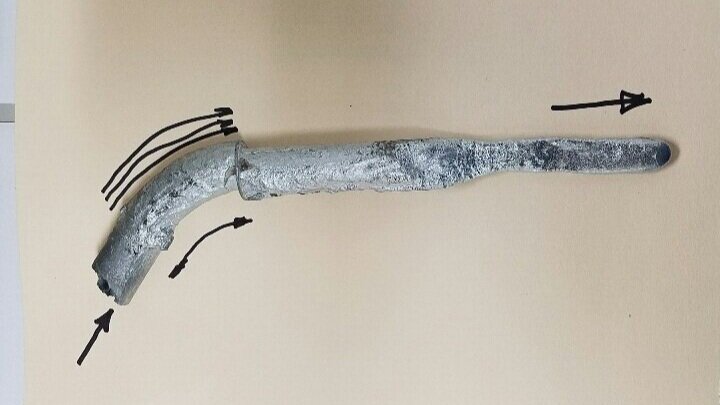Low Air Flow Freezes Pumps!
A slug of frozen zinc that was removed from a section of transfer piping after the operation halted.
This post is an addendum to the post titled Air-Supply Considerations For An Air Motor On A Molten Metal Pump.
The primary reason for molten metal pump freezing is "slow starts." A slow-start is defined as slowly increasing the motor RPM. When a transfer pump is slow-started, the hot metal flows gradually into a cooler riser. As the metal temperature decreases, it solidifies or freezes inside the riser. This slow-start condition typically results in permanent damage and the need to rebuild the pump or at the very least replace the riser.
Fast-starting a pump ensures that faster flowing molten metal heats the riser quickly to prevent freezing. A few seconds after steady flow is achieved via fast-start, the motor speed can be throttled back to a slower rate. Running a pump too slowly can always result in freezing regardless of the initial fast-start. Also, stopping the pump quickly and allowing the riser to thoroughly drain between transfers is critical. (Refer to Like a Launder Only Better for more details on best practices for a refractory lined pipe.)
Unlike the electric motor equipped with a VFD (variable frequency drive sometimes called in inverter that controls the acceleration, operating speed, and deceleration of the pump), the air motor is dependent on air supply plumbing and the operator for a fast-start. A fast-start requires proper air supply plumping as detailed in Air-Supply Considerations For An Air Motor On A Molten Metal Pump and an operator with the training and confidence to open the valve quickly to prevent freezing. It may be initially advantageous to direct the piping back into the metal bath to establish sufficient flow before starting the transfer process.
Several common problems include:
The use of quick couplings in the air supply plumbing. While quick couplings are convenient, they significantly restrict the airflow and reduce the pressure to the pump. Reduced pressure slows the start or results in stalls and frozen risers. Twist-claw connectors maybe be used, at a minimum of 3/4”, though 1” connectors and hose are recommended.
Similarly, the use of needle valves or limited-flow pressure regulators may cause pumps to stall or slow-start and result in a frozen riser.
Only full-flow operating valves, like ball valves, ensure adequate airflow to prevent freezing.

